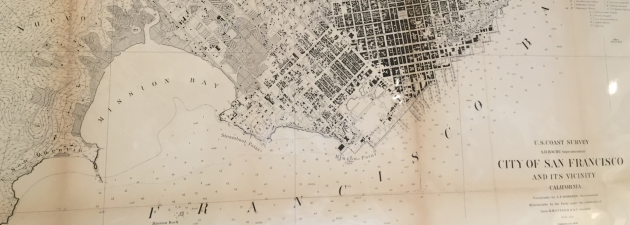Saturday
Apr022016
AAG 2016 wrap up
 Saturday, April 2, 2016 at 4:22PM
Saturday, April 2, 2016 at 4:22PM  1870s-ish map of SFAside from all the sunshine, architecture, maps, and food, at the 2016 AAG conference Kelly and I participated in four organized sessions on Historical Ecology. On Saturday, we heard from a number of fantastic researchers, and here is my wrap-up. (Alas, these sessions overlapped with sessions on CyberGIS, Who says you can't be interestd in both? cyber-historical-environmental-spatial-data-science.)
1870s-ish map of SFAside from all the sunshine, architecture, maps, and food, at the 2016 AAG conference Kelly and I participated in four organized sessions on Historical Ecology. On Saturday, we heard from a number of fantastic researchers, and here is my wrap-up. (Alas, these sessions overlapped with sessions on CyberGIS, Who says you can't be interestd in both? cyber-historical-environmental-spatial-data-science.)- History: We heard from researchers working on data from the Holocene, to pre-history, to the 20th century.
- Focus: Ecosystems included prairie, forests (Maryland, New York, California, Florida, Ohio); and Wetlands (China, California, etc.); Land Use and Agriculture (Mexico, Brazil); Fire (Arizona); and biological collections.
- Data included inventory (PLS system: land appraisal value; Cadastral surveys); Imagery (Landsat, aerial imagery); and biological (paleo; tree ring; resurveys; pollen records; bird census; and PLS system: witness trees, survey lines, FIA data).
- Methods: Comparison between past and present from existing inventory data, as well as comparison between historic and modern resurveys; digitization of multiple data sources; narrative analysis; ecological modeling; ecosystem services modeling; fire behavior modeling; OBIA of historic imagery; and some really neat modeling work.
- Emerging Themes from the sessions included:
- Data. Most people used digital data from an existing source - websites, clearinghouse, existing digital source. Many digitized their data. One person used an API.
- Accuracy. About half of speakers have thought about, or incorporated understanding of data quality or uncertainty in your work; but this is difficult to do quantitatively. Some people use the 'Multiple lines of evidence' from diverse datasets to increase confidence in results.
- Tools. We heard about a number of tools, including GIS as desktop tool, Open tools, Backcasting with landcover models, Complex modeling approaches, One paper used OBIA methods, and one paper discussed Big historic data (maybe moving toward the cyberGIS overlap).
- Theoretical frameworks: A few papers used resilience as a framework, social, ecological and coupled; and several papers used a landscape ecology framework.
- New terms: I learned a new term: “Terrageny”: a record of how a landscape became fragmented through time, containing information on the ‘ancestry’ of fragments and showing how an initially continuous landscape was progressively divided into fragments of decreasing size. Ewers et al. 2013. Gorgeous word. Must incorporate into cocktail party discussion.
We also sent out a survey to the speakers prior to the talks, and here are some preliminary results.
Question: What are the three top challenges that you see for historical ecology research?
- Data/Logistical/Availability
- The further back in time we look, the more sparse the data.
- Technical
- Lack of metadata: Current data deluge may attract attention/urgency away from the discovery and digitization of historical data;
- Few models capable of incorporating human and environment interactions over long time scales.
- Theoretical
- Maintaining perceived relevance in the context of the novel ecosystem/no-analog system conversation - not having historical ecology be the baby that is thrown out with the bathwater.
- Operational
- Many respondants mentioned issues with funding - these projects are by nature interdisciplinary, often require large programs to fund at achievable levels, and not many funding sources exist.
- Communication
- We need to focus on communicating the importance of understanding past conditions to inspire and guide current design proposals.
Question: What exciting future directions do you envision for historical ecology research?
- The importance of historical data and analysis:
- Historical data is essential: Multi- Inter-disciplinary research needs historical research, particularly so that we can understand 1) historical reference conditions, but also so that we can understand 2) when we might have novel interactions between species and ecosphere.
- Practicality of historical data and analysis:
- Historical ecology is critical for restoration projects and for studying climate change, and for its power to communicate through environmental education with the public.
- New data/Big data/Data Fusion:
- Increase in digitally available historical sources (longer ecological and climate records and reconstructions), plus the availability of large, high-resolution datasets to assess change (thinking LiDAR, government reports, survey data...)
- There is also increasing sophistication of analysis and visualization tools.
- But, the current data deluge may attract attention/urgency away from the discovery and digitization of historical data.
A fantastic time was had by all!
 Maggi | in
Maggi | in  conferences |
conferences |